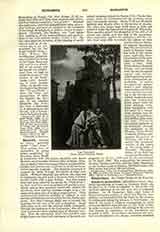

Elizabeth, SISTERS OF Saint, generally styled “Grey Nuns“. They sprang from an association of young ladies established by Dorothea Klara Wolff, in connection with the sisters, Mathilde and Maria Merkert, and Franziska Werner, 1842, in Neisse (Prussia), to tend in their own homes, without compensation, helpless sick persons who could not or would not be received into the hospitals. The members purposed to support the needy through the labor of their own hands. Without adopting any definite rule, they led a community life and wore a common dress, a brown woollen habit with a grey bonnet. For this reason they were soon called by the people the “Grey Nuns“. As their work was soon recognized and praised everywhere, and as new members continually applied for admission, their spiritual advisers sought to give the association some sort of religious organization. They endeavored, wherever possible, to affiliate it with already established confraternities having similar purposes. But their foremost desire was to educate the members for the care of the sick in hospitals. Great difficulties arose, and the attempt failed, principally through the resistance of the foundresses, who did not wish to abandon their original plan of itinerant nursing. Thus the association which had justified such bright hopes was dissolved, and many of the newly admitted members joined the Sisters of St. Charles Borromeo, while the foundresses left the novitiate which they had already entered. Klara Wolff and Mathilde Merkert died shortly after, in the service of charity. The other two began their work anew in 1850 and placed it under the especial patronage of St. Elizabeth. They speedily gained the sympathy of the sick of all classes and creeds, and also that of the physicians. New candidates applied for admission, and the sisters were soon able to extend the sphere of their activity beyond Neisse. Of especial importance was the foundation made at Breslau, where the work of the sisters came under the direct observation of the episcopal authorities. Soon after, September 4, 1859, Prince-Bishop Heinrich Förster was prevailed upon by the favorable reports and testimonials to grant the association ecclesiastical approbation. As such a recognition presupposed a solid religious organization, novitiate was established according to the statutes submitted. In the following year the twenty-four eldest sisters made the three religious vows. State recognition, with the grant of a corporation charter, was obtained by the confraternity May 25,1864, under the title, “Catholic Charitable Institute of St. Elizabeth“, through the mediation of the Prussian Crown-Prince Frederick William, subsequent Emperor of Germany, who had observed the beneficent activity of the sisters on the battlefields of Denmark. The approbation of the Holy See was granted for the congregation on January 26, 1887, and for its constitutions on April 26, 1898. The congregation has spread to Norway, Sweden, and Italy, and has (1908), dependent on the motherhouse at Breslau, 305 filial houses, with 2565 sisters and about 100 postulants.

